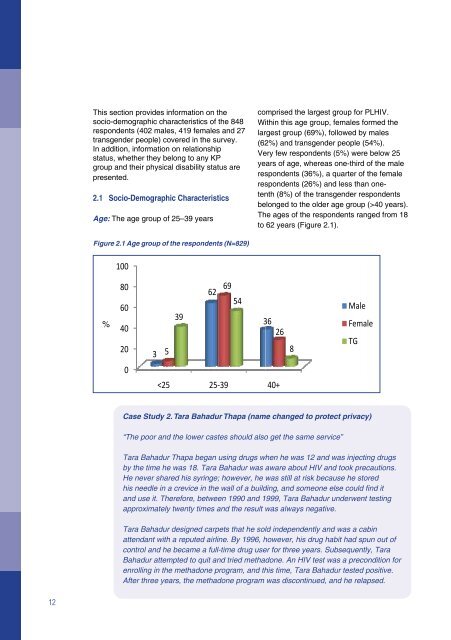PLHIV Stigma Index in Nepal
PLHIV Stigma Index in Nepal
PLHIV Stigma Index in Nepal
- No tags were found...
You also want an ePaper? Increase the reach of your titles
YUMPU automatically turns print PDFs into web optimized ePapers that Google loves.
This section provides <strong>in</strong>formation on thesocio-demographic characteristics of the 848respondents (402 males, 419 females and 27transgender people) covered <strong>in</strong> the survey.In addition, <strong>in</strong>formation on relationshipstatus, whether they belong to any KPgroup and their physical disability status arepresented.2.1 Socio-Demographic CharacteristicsAge: The age group of 25–39 yearsFigure 2.1 Age group of the respondents (N=829)%100806040200396240 years).The ages of the respondents ranged from 18to 62 years (Figure 2.1).3626Case Study 2. Tara Bahadur Thapa (name changed to protect privacy)40+8MaleFemaleTGFollow<strong>in</strong>g this, Tara Bahadur checked <strong>in</strong>to Youth Vision rehabilitation. “YouthVision taught me that to quit, the most important th<strong>in</strong>g is chang<strong>in</strong>g attitudes andbehaviours.” On his release from the centre, he opted to volunteer at a VCTcentre. Before beg<strong>in</strong>n<strong>in</strong>g his work, he voluntarily decided to check his HIV status,as he did not believe that he was actually HIV-positive. On learn<strong>in</strong>g his status,he was devastated and felt the urge to start tak<strong>in</strong>g drugs aga<strong>in</strong>. Fortunately, hiscounsellor and friends from the VCT centre prevented him from relaps<strong>in</strong>g. Aftertwelve anxious days, Tara Bahadur disclosed his status to his wife and follow<strong>in</strong>ghis counsellor’s advice, took his wife for counsell<strong>in</strong>g.Tara Bahadur began provid<strong>in</strong>g counsell<strong>in</strong>g and community support to others asa corollary to need<strong>in</strong>g them himself. He also founded a care home to providecomprehensive services to <strong>PLHIV</strong>. Over his six years of help<strong>in</strong>g other <strong>PLHIV</strong>, TaraBahadur is proudest of hav<strong>in</strong>g saved many people’s lives by enabl<strong>in</strong>g despondentfamilies access care and treatment services for their HIV-positive family members,thereby help<strong>in</strong>g them live.Tara Bahadur’s overarch<strong>in</strong>g concerns about treatment and care relate to theimbalance of services provided across the country and different communities andhe recognizes that his current success eases his own experience of liv<strong>in</strong>g withHIV. As an advocate, however, he is dissatisfied with this situation and believesthat everyone should get equal treatment. Tara Bahadur adds that caste- andclass-based discrim<strong>in</strong>ation also prevents impoverished patients from receiv<strong>in</strong>gequal treatment.To help alleviate some of these imbalances, Tara Bahadur recommends betteravailability of services, <strong>in</strong>clud<strong>in</strong>g more antiretroviral therapy cl<strong>in</strong>ics and viral loadmach<strong>in</strong>es. He adds that free follow-up test<strong>in</strong>g for HIV would be a useful measureto equalize service regardless of class.“The poor and the lower castes should also get the same service”Tara Bahadur Thapa began us<strong>in</strong>g drugs when he was 12 and was <strong>in</strong>ject<strong>in</strong>g drugsby the time he was 18. Tara Bahadur was aware about HIV and took precautions.He never shared his syr<strong>in</strong>ge; however, he was still at risk because he storedhis needle <strong>in</strong> a crevice <strong>in</strong> the wall of a build<strong>in</strong>g, and someone else could f<strong>in</strong>d itand use it. Therefore, between 1990 and 1999, Tara Bahadur underwent test<strong>in</strong>gapproximately twenty times and the result was always negative.Tara Bahadur designed carpets that he sold <strong>in</strong>dependently and was a cab<strong>in</strong>attendant with a reputed airl<strong>in</strong>e. By 1996, however, his drug habit had spun out ofcontrol and he became a full-time drug user for three years. Subsequently, TaraBahadur attempted to quit and tried methadone. An HIV test was a precondition forenroll<strong>in</strong>g <strong>in</strong> the methadone program, and this time, Tara Bahadur tested positive.After three years, the methadone program was discont<strong>in</strong>ued, and he relapsed.Education: Relatively, female respondentshad lower levels of education compared to themale respondents and transgender people.A considerable proportion of the femalerespondents, that is, 44 per cent, had neverattended school, whereas this percentagewas only 5 per cent and 4 per cent for malesand transgender people, respectively. Asignificant number of respondents (females:20%, males: 18% and transgender people:12%) had attended either non-formaleducation (NFE) or had jo<strong>in</strong>ed school, but notcompleted their primary level of education.Approximately 15 per cent of the females, 16per cent of the transgender people and 40 percent of the males had completed their lowersecondary/secondary education. Although theSchool Leav<strong>in</strong>g Certificate (SLC) course andhigher education had been completed by 64per cent of the transgender respondents, thispercentage was only 10 per cent for the malerespondents and 4 per cent for the femalerespondents. (Figure 2.2).Employment status: One-sixth of the12 13
















